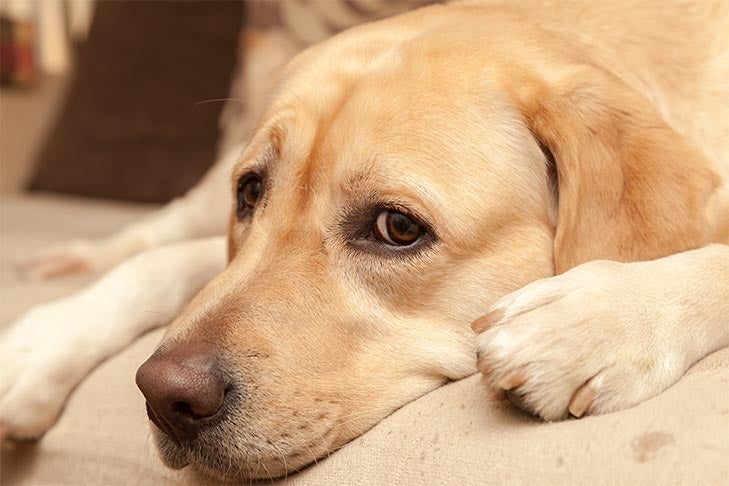When it comes to the dog flu, it’s important to always be prepared. While most cases are not fatal, the canine influenza virus can make your pup uncomfortably sick, and cause you both a lot of stress and time spent at the vet’s office. If you are a dog owner, you don’t need to panic about the dog flu, but you should familiarize yourself with the symptoms so that you know what to look for in the event of an outbreak in your area.
What Is Dog Flu?
Dog flu, or canine influenza virus, is an infectious respiratory disease caused by an influenza A virus, similar to the viral strains that cause influenza in people. There are two known strains of dog flu found in the United States:
- H3N8
- H3N2
The H3N8 strain actually originated in horses. The virus jumped from horses to dogs, becoming a canine influenza virus around 2004, when the first outbreaks affected racing Greyhounds at a track in Florida.
H3N2, on the other hand, originated in Asia, where scientists believe it originated from birds before affecting dogs. H3N2 is the virus responsible for the 2015 and 2016 outbreaks of canine influenza in the Midwest and continues to spread throughout the United States.
How Is Canine Influenza Spread?
Like human forms of influenza, dog flu is airborne. Respiratory secretions escape into the environment in the form of coughing, barking, and sneezing, where they are then inhaled by a new canine host. The dog flu also spreads through contaminated objects and environments, like water bowls, collars, and kennel surfaces, or through contact with people who have had direct contact with an infected dog.

Crowded areas like kennels, grooming parlors, daycare centers, and dog parks are breeding grounds for diseases like canine influenza. The close proximity of the dogs means that a barking, coughing, or sneezing dog can easily infect canines around them. This is made more dangerous by the fact that dogs are most contagious during the incubation period before they start exhibiting symptoms.
How Long Are Dogs Infected With Dog Flu Contagious?
The incubation period of canine influenza is approximately two-to-four days from initial exposure to the dog flu virus. Viral shedding starts to decrease after the fourth day, but dogs with H3N8 remain contagious for up to 10 days after exposure, and dogs with H3N2 remain contagious for up to 26 days. Most vets recommend isolating dogs with H3N2 for at least 21 days to reduce the risk of transmission.
Almost all dogs that come into contact with the disease will contract it, but not all dogs that become infected show symptoms of the virus. About 20-25% of dogs that infected are asymptomatic, but these dogs can still spread the disease. If one of your canine companions catches the flu, but the other seems unaffected, remember that he could still have the virus. Talk to your vet about quarantine procedures for all dogs in your household.
Symptoms of Dog Flu
So, how do you know if your dog has canine influenza? There are several symptoms all owners should be aware of. Dog flu cases range from mild to severe and, unlike human influenzas, are not seasonal. Keep an eye out for the following symptoms year-round:
- Coughing (both moist and dry)
- Sneezing
- Nasal discharge
- Purulent nasal discharge
- Runny eyes
- Fever
- Lethargy
- Difficulty breathing
Dog flu symptoms resemble kennel cough symptoms, which is also an illness you should talk to your veterinarian about as soon as you notice symptoms.

Most cases of dog flu are mild, but severe cases can occur. In those instances, dogs can develop pneumonia, difficulty breathing, and a high fever. Luckily, the mortality rate is relatively low, with less than 10% of dog flu cases resulting in fatalities.
Dog Flu Treatments
The canine influenza virus requires the attention of a veterinarian. In some states, vets are required to report cases of canine influenza to the government to help monitor the spread of the disease.
There is no cure for dog flu. Treatment is supportive, and your veterinarian can advise you on the best ways to keep your dog comfortable during his illness and recovery. Some dogs may require supportive care, such as fluids, to aid their recovery, as well as nonsteroidal anti-inflammatory medications to reduce fevers. Your vet will help you come up with a nutritional plan and may prescribe antibiotics to treat secondary bacterial infections.
Your vet will also inform you about appropriate quarantine procedures to prevent the spread of dog flu, depending on the strain of the virus your dog contracts, and can give you information about disinfectant solutions to use in your home to help kill the virus.
Call your vet ahead of time to let her know that your dog is showing symptoms of a respiratory infection. Both kennel cough and dog flu are highly contagious, and your vet may request that you keep your dog outside until your appointment time to prevent the risk of transmission to other patients in the waiting room.
Preventing Dog Flu
The best way to prevent your dog from contracting dog flu is to keep them away from public places or kennels with recently reported cases. If you come into contact with a dog that you suspect has dog flu or has recently been exposed to it, wash your hands, arms, and clothing before touching your own dog. This will reduce the risk of transmission from you to your dog.
There are vaccines available for both the H3N8 and H3N2 strains of canine influenza. Your vet may recommend the vaccine based on your lifestyle. For instance, if you live in an area with a high incidence of dog flu or if your dog regularly spends time in kennels or travels to shows around the country, then they could be at an increased risk of contracting canine influenza and your vet may recommend the vaccine as a precaution.

